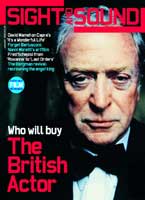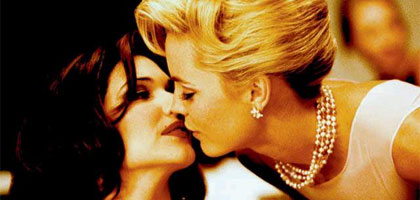
Mulholland Dr.
France/USA 2001

Reviewed by Kim Newman
Synopsis
Our synopses give away the plot in full, including surprise twists.
Los Angeles. A woman being driven in a limousine up Mulholland Drive realises she is about to be murdered. Two cars, driven by drag-racing kids, crash into the limo before the hit can be executed. The woman staggers away, taking refuge in the apartment of Ruth, a movie star who is just leaving town. Betty Elms, Ruth's aspiring actress niece, is shown into the apartment by the manager of the complex, Coco Lenoix, and finds the woman, who calls herself Rita but can't remember her real name, in the shower. In a diner called Winkie's, a man confides to another that he has had a bad dream set around the corner; when they venture there, the dreamer has a seizure at the sight of a burned derelict.
Adam Kesher, a young film director, resists the shadowy backers of his current project, who want him to cast an actress named Camilla Rhodes in the lead. A hit man executes a murder that becomes complicated by absurd circumstances, then begins a search for a 'new girl' on the street. Adam discovers his wife is having an affair with the pool man, and that agents of the backers have cut off access to his money. Betty volunteers to help Rita, whose handbag contains a lot of money and a blue key, find out who she is. Adam has a midnight rendezvous with a strange figure called the Cowboy who scares him into going along with the backers. Rita seems to remember the name Diane Selwyn and Betty arranges to accompany her to the woman's listed address, but first takes an audition at the studio where Adam works. She is ferried from the audition, where she is impressive, to the set where Adam is casting. The director notices Betty but casts Camilla Rhodes. Betty leaves to keep her appointment with Rita. They find Diane's corpse and, unsettled by the experience, draw closer, sleeping together. Rita wakes up and is compelled to go, along with Betty, to a theatre called Silencio, where they find a blue box that matches the key.
When the box is opened, Betty finds she is living a version of Diane's life and Rita has become movie star Camilla. Diane, Camilla's jealous lover, is upset when Adam and Camilla announce their engagement and hires the hit man to kill Camilla. The murderer promises to leave an ordinary blue key as a token that the kill has been carried out, but Diane - harried by an imp-like couple who had befriended Betty on the plane to Los Angeles - commits suicide.
Review
For all its mood shifts from black wit to sheer terror (Peter Deming's camerawork creeps around corners and into darkened rooms to discover a Medusa-faced derelict or corpses glistening with rot), David Lynch's Mulholland Dr. is disturbingly all of a piece. This belies the fact that the first two thirds are a re-edit of a series pilot for ABC that was shot two years ago, only to be shelved by the puzzled network. The sequences that comprise the rest of the movie, meanwhile, are add-ons, invented to transform an open-ended pilot into a film offering, if not closure, at least circularity. Either section can be read as a 'dream' version of the other's 'reality' - though things are never that simple in Lynch's world of dreams within dreams. Moments of explicit fantastica recur throughout, leaving wide open (and irrelevant?) the question of whether television or film is the more 'real' medium. It's as if Lynch had side-stepped a couple of seasons of up-and-down intrigue and segued directly from the Twin Peaks pilot to the theatrical Twin Peaks Fire Walk With Me. He at once establishes and destroys a fictional universe, while probing the nature of narrative and performance, offering the practice of karaoke mime (demonstrated by Dean Stockwell in Blue Velvet) as a metaphor for all human activity.
The third act recasts what has gone before, as aspiring Hollywood star turned plucky amateur detective Betty Elms discovers that she is also Diane Selwyn, the corpse in the case she's been investigating. Since Peg Entwistle jumped off the Hollywood Sign in 1932, the story of the wide-eyed starlet who comes to Hollywood, only to find that it's a circle of hell, has been endlessly retold. Mulholland Dr. seems to have a contemporary setting, but sweet Betty is from another time and place, the winner of an anachronistic jitterbug contest. As herself, Betty is deliberately unconvincing, always bright and generous, sure of her predestined stardom and yet, while running over lines for an audition, a woefully amateur actress. As someone else, however, she is much more convincing: when she takes the audition, she delivers a calculated and impressive performance, setting up the third-act segue when Betty is reincarnated as Diane (much in the same way that Bill Pullman became Balthazar Getty for a stretch of Lost Highway). Here, Naomi Watts shows real attack as Diane, the tagalong girlfriend about to be dropped by the big star.
Betty comes to Hollywood not to be in films but to be in a story. She mixes with the melodramatic, voluptuous Rita, who takes her name from a Gilda poster and comes complete with noir baggage (amnesia, a purse full of cash, a mystery key). The two women run through several possible versions of an anecdote just as Jacques Rivette's Céline and Julie enter a house which is at once a cyclical ghost story and an endlessly recut film, while their identities meld and switch like Millie and Pinky's in Robert Altman's 3 Women (1977). The knowing co-option of elements from previous films even extends to a lesbian love scene that appears modelled on an encounter in an obscure porno movie one suspects might have attracted Lynch's attention, Gary Wells' Twin Peeks (1990). After erotic fantasy, Lynch delivers a scene of literal self-abuse, as the rejected Diane angrily masturbates, one of several scenes that just might constitute a waking frame for the dreamed whole.
The prevailing spirit of the film is a figure from Hispanic-American folklore, la llorona ('the crying woman'). Like the Irish banshee, la llorona is a spectre, the ghost of a mother who has lost or killed her children, who wails in advance of tragedy. The film is infested with manifestations of this figure - anguished or fussy maternal characters such as Ann Miller's chatty landlady, or terrifying apparitions like the face-fried derelict. At Silencio, the midnight vaudeville theatre (latest of Lynch's luridly imagined infernal nightclubs) where Betty and Rita find the blue box that matches Rita's mysterious key, the star turn is 'la Llorona de Los Angeles', a chanteuse who outdoes Dean Stockwell's performance of 'In Dreams' by delivering an extraordinary mime in sync with a Spanish-language cover of Roy Orbison's 'Crying' only to collapse half-way through as the track continues. Miming to playback, with its implications of a willing surrender of one identity to usurp and yet undermine another, also features as the young film director Adam auditions actresses for his musical, by having them lip-sync terrifying kitsch - Connie Stevens' 'Sixteen Reasons (Why I Love You)'. All this points to the way Betty is somehow forced to life-sync for Diane, or Diane dreams of a happier ending as Betty.
The film concentrates on Betty and Rita, but the television series, now itself a might-have-been ghost, would presumably have developed the cops played by Robert Forster and Brent Briscoe as well as other intriguing but little-seen characters. Played with a Kyle MacLachlan squareness by Justin Theroux, Adam suffers most in the reshoot, a wooden support to the nuanced readings of Watts and Laura Elena Harring as Diane and movie star Camilla. He's marvellously unsettled, however, in his first, truncated storyline. There have been Hollywood horror stories before, but only Lynch would stage production meetings as ritual torture or ghostly encounters. The supposed power players turn out to be trapped between the wills of a Mabuse-Howard Hughes figure in the basement (Michael J. Anderson in a prosthetic body) and sinister backers who present their choice for lead role, Camilla, as a fait accompli ('This is not a suggestion'). His sharp black suit absurdly splattered with bright magenta, Adam learns his whole life is dependent on going along with the creative input of the money men, who have the power to ruin his credit at a cash-only flop-house. To get back on track, he takes a midnight meeting at the top of Mulholland Drive where a buzzing lightbulb flares to announce the arrival the Cowboy, a successor to Twin Peaks' Killer BOB and Lost Highway's mystery man as a representative of supernaturally organised crime.
A film bound to irritate audiences who want to emerge with a cut-and-dried sense of what they've seen, this follows the aptly-titled The Straight Story by taking a literally crooked road (Mulholland Drive, of course), with byways into Hollywood satire, criminal intrigue, horror and backstage musical. It certainly contains as much material as any television series could manage, never quoting, evoking or imitating without subsuming the raw material into its own unique world. Films as emotionally overwhelming as Mulholland Dr. often seem shallower with further acquaintance, but this shows signs of being a lasting work, a film that shifts and changes along with the viewer, upon which all commentary is necessarily provisional.
Credits
- Director
- David Lynch
- Producers
- Mary Sweeney
- Alain Sarde
- Neal Edelstein
- Michael Polaire
- Tony Krantz
- Screenplay
- David Lynch
- Director of Photography
- Peter Deming
- Editor
- Mary Sweeney
- Production Designer
- Jack Fisk
- Music/Music Conductor
- Angelo Badalamenti
